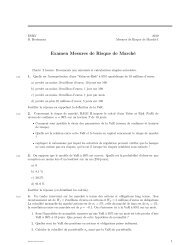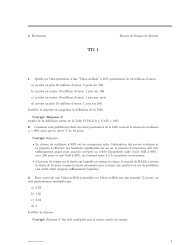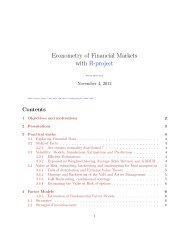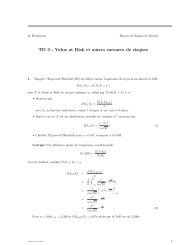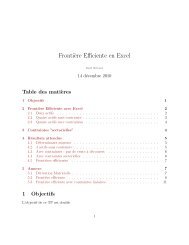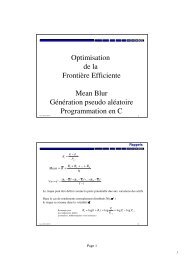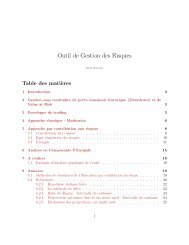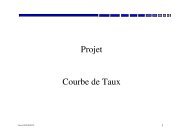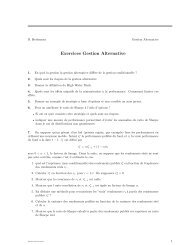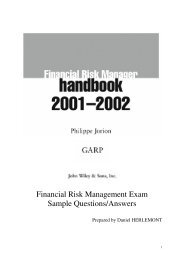Financial Risk Management Exam Sample Questions - Yats.com
Financial Risk Management Exam Sample Questions - Yats.com
Financial Risk Management Exam Sample Questions - Yats.com
You also want an ePaper? Increase the reach of your titles
YUMPU automatically turns print PDFs into web optimized ePapers that Google loves.
<strong>Financial</strong> <strong>Risk</strong> <strong>Management</strong> <strong>Exam</strong><strong>Sample</strong> <strong>Questions</strong>Prepared by Daniel HERLEMONT1
PART I - QUANTITATIVE ANALYSIS_________________________________________ 3Chapter 1 - Bunds Fundamentals__________________________________________________ 3Chapter 2 - Fundamentals of Probability ___________________________________________ 7Chapter 3 – Fundamentals of Statistics ____________________________________________ 11Chapter 4 - Monte Carlo Methods ________________________________________________ 13PART I - CAPITAL MARKETS ______________________________________________ 17Chapter 5 - Introduction to Derivatives____________________________________________ 17Chapter 6 - Options ____________________________________________________________ 18Chapter 7 - Fixed In<strong>com</strong>e Securities ______________________________________________ 22Chapter 8 - Fixed In<strong>com</strong>e Derivatives _____________________________________________ 28Chapter 9 - Equity Market ______________________________________________________ 31Chapter 10 - Currency and Commodities Markets __________________________________ 33PART III - MARKET RISK MANAGEMENT___________________________________ 36Chapter 11 - Introduction to <strong>Risk</strong> Measurement ____________________________________ 36Chapter 12 - Identification of <strong>Risk</strong> Factors_________________________________________ 38Chapter 13 - Sources of <strong>Risk</strong> ____________________________________________________ 40Chapter 14 - Hedging Linear <strong>Risk</strong> ________________________________________________ 44Chapter 15 - Non Linear <strong>Risk</strong>: Options____________________________________________ 47Chapter 16 - Modelling <strong>Risk</strong> Factors______________________________________________ 52Chapter 17 - VaR Methods ______________________________________________________ 53PART IV - Credit <strong>Risk</strong> <strong>Management</strong>___________________________________________ 55Chapter 18 - Introduction to Credit <strong>Risk</strong> __________________________________________ 55Chapter 19 - Measuring Actuarial Default <strong>Risk</strong>_____________________________________ 58Chapter 20 - Measuring Default <strong>Risk</strong> from Market Prices ____________________________ 63Chapter 21 - Credit Exposure____________________________________________________ 65Chapter 22 - Credit Derivatives __________________________________________________ 71Chapter 23 - Managing Credit <strong>Risk</strong>_______________________________________________ 75PART V - OERATIONAL AND INTEGRATED RISK MANAGEMENT_____________ 79Chapter 24 - Operational <strong>Risk</strong> ___________________________________________________ 79Chapter 25 - <strong>Risk</strong> Capital and RAROC ___________________________________________ 82Chapter 26 - Best Practices Reports ______________________________________________ 84Chapter 27 - Firmwide <strong>Risk</strong> <strong>Management</strong> _________________________________________ 84Chapter 31 - The Basle Accord___________________________________________________ 89Chapter 32 - The Basle <strong>Risk</strong> Charge ______________________________________________ 912
PART I - QUANTITATIVE ANALYSISChapter 1 - Bunds Fundamentals3
Chapter 2 - Fundamentals of Probability7
Chapter 3 – Fundamentals of StatisticsFRM-99, Question 4Random walk assumes that returns from one time period are statistically independent from another period. Thisimplies:A. Returns on 2 time periods can not be equal.B. Returns on 2 time periods are uncorrelated.C. Knowledge of the returns from one period does not help in predicting returns from another periodD. Both b and c.FRM-99, Question 14Suppose returns are uncorrelated over time. You are given that the volatility over 2 days is 1.2%. What is thevolatility over 20 days?A. 0.38%B. 1.2%C. 3.79%D. 12.0%FRM-98, Question 7Assume an asset price variance increases linearly with time. Suppose the expected asset price volatility for thenext 2 months is 15% (annualized), and for the 1 month that follows, the expected volatility is 35% (annualized).What is the average expected volatility over the next 3 months?A. 22%B. 24%C. 25%D. 35%FRM-97, Question 15The standard VaR calculation for extension to multiple periods assumes that returns are serially uncorrelated. Ifprices display trend, the true VaR will be:A. the same as standard VaRB. greater than the standard VaRC. less than the standard VaRD. unable to be determinedFRM-99, Question 2Under what circumstances could the explanatory power of regression analysis be overstated?A. The explanatory variables are not correlated with one another.B. The variance of the error term decreases as the value of the dependent variable increases.C. The error term is normally distributed.D. An important explanatory variable is excluded.FRM-99, Question 20What is the covariance between populations a and b:a 17 14 12 13b 22 26 31 29A. -6.25B. 6.50C. -3.61D. 3.61FRM-99, Question 6Daily returns on spot positions of the Euro against USD are highly correlated with returns on spot holdings ofYen against USD. This implies that:A. When Euro strengthens against USD, the yen also tends to strengthens, but returns are not necessarily equal.B. The two sets of returns tend to be almost equalC. The two sets of returns tend to be almost equal in magnitude but opposite in sign.D. None of the above.11
FRM-99, Question 10You want to estimate correlation between stocks in Frankfurt and Tokyo. You have prices of selected securities.How will time discrepancy bias the <strong>com</strong>puted volatilities for individual stocks and correlations between thesetwo markets?A. Increased volatility with correlation unchanged.B. Lower volatility with lower correlation.C. Volatility unchanged with lower correlation.D. Volatility unchanged with correlation unchanged.FRM-00, Question 125If the F-test shows that the set of X variables explains a significant amount of variation in the Y variable, then:A. Another linear regression model should be tried.B. A t-test should be used to test which of the individual X variables can be discarded.C. A transformation of Y should be made.D. Another test could be done using an indicator variable to test significance of the model.FRM-00, Question 112Positive autocorrelation of prices can be defined as:A. An upward movement in price is more likely to be followed by another upward movement in price.B. A downward movement in price is more likely to be followed by another downward movement.C. Both A and B.D. Historic prices have no correlation with future prices.FRM-00, Question 112Positive autocorrelation of prices can be defined as:A. An upward movement in price is more likely to be followed by another upward movement in price.B. A downward movement in price is more likely to be followed by another downward movement.C. Both A and B.D. Historic prices have no correlation with future prices.12
Chapter 4 - Monte Carlo Methods13
PART I - CAPITAL MARKETSChapter 5 - Introduction to Derivatives17
Chapter 6 - Options18
Chapter 7 - Fixed In<strong>com</strong>e Securities22
Chapter 8 - Fixed In<strong>com</strong>e Derivatives28
Chapter 9 - Equity Market31
Chapter 10 - Currency and Commodities Markets33
PART III - MARKET RISK MANAGEMENTChapter 11 - Introduction to <strong>Risk</strong> Measurement36
Chapter 12 - Identification of <strong>Risk</strong> Factors38
Chapter 13 - Sources of <strong>Risk</strong>40
Chapter 14 - Hedging Linear <strong>Risk</strong>44
Chapter 15 - Non Linear <strong>Risk</strong>: Options47
Chapter 16 - Modelling <strong>Risk</strong> Factors52
Chapter 17 - VaR Methods53
PART IV - Credit <strong>Risk</strong> <strong>Management</strong>Chapter 18 - Introduction to Credit <strong>Risk</strong>55
Chapter 19 - Measuring Actuarial Default <strong>Risk</strong>58
Chapter 20 - Measuring Default <strong>Risk</strong> from Market Prices63
Chapter 21 - Credit Exposure65
Chapter 22 - Credit Derivatives71
Chapter 23 - Managing Credit <strong>Risk</strong>75
PART V - OERATIONAL AND INTEGRATED RISKMANAGEMENTChapter 24 - Operational <strong>Risk</strong>79
Chapter 25 - <strong>Risk</strong> Capital and RAROC82
Chapter 26 - Best Practices ReportsChapter 27 - Firmwide <strong>Risk</strong> <strong>Management</strong>84
Chapter 31 - The Basle Accord89
Chapter 32 - The Basle <strong>Risk</strong> Charge91


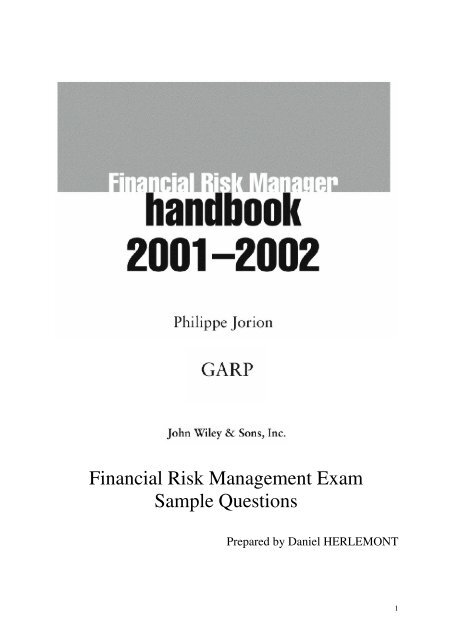

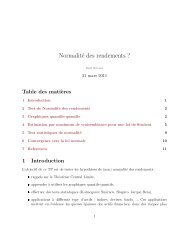
![[pdf] sujet - Yats.com](https://img.yumpu.com/51163493/1/190x245/pdf-sujet-yatscom.jpg?quality=85)
